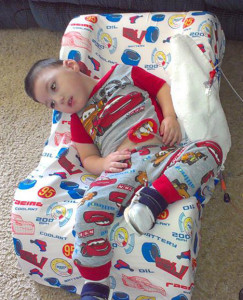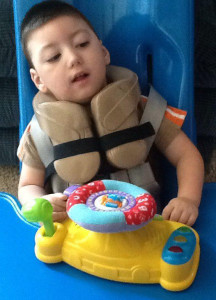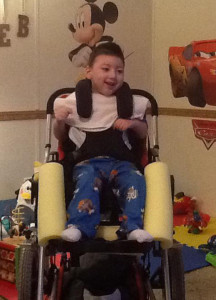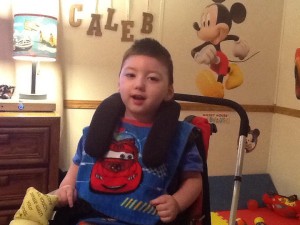 Background Information:
Background Information:
Caleb is a 35 month old male with a diagnosis of congenital CMV. He is a relatively healthy child, but does suffer from chronic respiratory infections, occasionally requiring supplemental oxygen. Other diagnoses include: seizure disorder, central sleep apnea, hip subluxation, scoliosis, dysphagia, cortical vision impairment, and developmental delay.
When supine, seated, or in supported standing, Caleb frequently exhibits right lateral trunk flexion, R lateral cervical flexion, and left cervical rotation (see photos below). It is thought that Caleb may by positioning himself in this manner to orient his vision. He also frequently exhibits extensor tone, “throwing” his head and trunk backwards. Caleb’s mom was primarily concerned with Caleb’s positioning in his wheelchair.
 He has a tendency to “wedge” his head between the wheelchair back and his standard headrest. He was then unable to return his head to upright, requiring frequent repositioning by caregivers.
He has a tendency to “wedge” his head between the wheelchair back and his standard headrest. He was then unable to return his head to upright, requiring frequent repositioning by caregivers.
INTERVENTION
Caleb’s standard headrest was replaced with a Stealth i2i head, neck, and shoulder positioning system in order to promote midline head position and offer cervical support, while still allowing full cervical rotation and not obscuring vision. It also decreased the size of the contact surface with the back of Caleb’s head.
 CONCLUSION
CONCLUSION
With the Stealth i2i, Caleb is no longer at risk for head entrapment between his wheelchair back and headrest. The i2i allows freedom of cervical movement, with boundaries to limit excessive neck extension and anterior trunk flexion. While seated in his wheelchair, caregivers report improved eye contact, increased vocalization, improved management of secretions, decreased overall extension, and less time spent repositioning Caleb.

